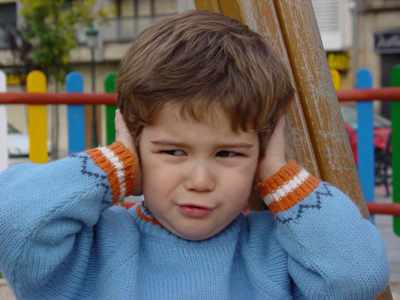|
| |
How Hyperacusis Is Helped with Auditory
Integration Training
Read More About How Hyperacusis Differs from Hyperacute (Hyper Sensitive) Hearing
Contact Us
Complete
On-line AIT Checklist

|
Berard
AIT is an intervention designed for individuals both with hyperacute - hypersensitive
hearing and distorted auditory processing.
Although
the words are used interchangeably, clinical audiologists
typically use the term HYPERACUSIS for diagnostic purposes.
The differences between
HYPERACUSIS and HYPERSENSITIVE HEARING are:
-
HYPERACUSIS
means reduced
tolerance to supra-threshold sounds. Sounds that can be
tolerated by others but annoying, uncomfortable, and in some
cases painful to others. The origin is typically considered to
be in a central auditory system.
-
HYPERSENSITIVE
TO SOUND is thought of as having extra-good hearing
thresholds. Thresholds per se that are in the better than
normal ranges versus normal or hearing loss ranges. If it is
hearing threshold related, then it is within the cochlea.
-
It is possible to
have both
HYPERACUSIS and HYPERSENSITIVE HEARING.
Please discuss the
details and differences in these diagnoses in with your
AIT Practitioner or a
clinical audiologist.
|
What is Hyperacusis?
Excerpts from
web article by Dan Malcore:
- Hyperacusis is defined as a "collapsed
tolerance to normal environmental sounds".
Some
people with hyperacusis have such a severe collapsed tolerance to
sound, that it may be difficult and sometimes impossible for them
to remain in the mainstream of life enduring all the environmental
noise which comes with living in the world today. ALL sounds may be
perceived as too loud, although the high frequencies are particularly
troublesome.
- Hyperacusis differs from hypersensitive
hearing, which is an abnormal growth in the perception of loudness
accompanied with hearing loss.
- With hyperacusis, all sounds
are too loud.
- With hypersensitive
hearing, loud noises are uncomfortable.
- Individuals with
hyperacusis
often report they perceive sound - even their own voice - as
uncomfortably loud and this
not only causes tinnitus to increase but may also cause inner ear
discomfort or a popping reflex in the ear.
- The person
who has hyperacusis can't simply get up and walk
away from noise. Instead, the volume on the whole world seems stuck
on high. Everyday noises sound unbearably
or painfully loud.
- With hyperacusis, ears also
lose most of their dynamic range.
-
Dynamic range is the ability of the ear to deal with quick shifts
in sound loudness. he disorder is often chronic and usually
accompanied by tinnitus (ringing in the ears)
but can occur in Individuals who have little or no measurable hearing
loss.
- Hyperacusis can be devastating
to the person's career, relationships, and peace of mind. Finding
the proper diagnosis is difficult because few doctors understand hyperacusis.
- Many Individuals
with hyperacusis
complain of ear discomfort, a feeling of fullness or burning sensation
in the ears.
- Most individuals with hyperacusis
also experience inner ear pain or a feeling of fullness (pressure)
in the ears.
- Hyperacusis
makes living in this noisy world difficult and dramatically changes
the person's pattern of life. Moving about, traveling, and
communicating with others is challenging.
- Ear protection must be worn in areas that seem too
loud. This includes earplugs, industrial earmuffs or both if necessary.
- Some people with
hyperacusis actually try to change the pitch
of their own voice to accommodate their ears. This may help their
ears but the person can become hoarse in the process.
Hearing Loss and Hyperacusis
-
There
is little to no detectable hearing loss with hyperacusis and all tests
will confirm an individual's ears to be perfectly normal.
-
For that reason many doctors are
dumbfounded and give the individual's hearing a clean bill of health.
-
Some individuals with severe hyperacusis
can produce
Audiogram
or a Listening Test
that show they can hear at minus decibel levels.
-
Because of this, hyperacusis
individuals may feel that in addition to having a collapsed tolerance
to sound, they can suddenly hear better than those with normal ears.
Tinnitus and Hyperacusis
-
Many with hyperacusis or
recruitment suffer from varying degrees of tinnitus (ringing
in the ears or head noises). All these conditions can be disabling
depending on their severity. For many individuals, the problem is
three-fold:
1. A collapsed tolerance to sound means these individuals
have a difficult time listening to sounds which exceed 60
decibels (the sound of someone talking).
2. A dynamic range is so narrowed these individuals
cannot handle quick shifts in noise intensity.
3. Tinnitus (ringing in the ears or head
noise) disrupts even an individual's quiet time and ability
to sleep.
What Causes Hyperacusis?
No one knows the answer to solving an individual's these
hearing problems, but some clues are beginning to surface.
-
Currently a popular theory is that
there has been a breakdown or dysfunction in the efferent
portion of the auditory nerve: efferent meaning fibers that
originate in the brain which serve to regulate or inhibit incoming
sounds.
-
Some believe it involves the facial
nerve.
If the cause would be damage
to the auditory nerve then why does hyperacusis most often show up in
individuals who have no hearing loss?
-
One possibility is that efferent
fibers of the auditory nerve are selectively damaged even though the
hair cells that allow us to hear pure tones in an audiometry evaluation
remain intact.
-
Others believe the central processing
unit which processes sound has been altered. Others believe it is
a combination of both. These are only theories that have not been
proven.
Treatment of Hyperacusis
-
Many individuals with hyperacusis
have gotten better over time and some see little to no improvement. Ears
heal so slowly, yet time is a great healer.
-
Much improvement depends on the
kind of advice received when individuals first come down with a collapsed
tolerance to sound.
-
So few doctors know anything about
this condition, that individuals rarely get good advice and
frequently hearing tests are administered to them which can make an
individual's condition even worse (MRI or Brainstem Evoke
test).
Before any hearing tests are
performed on an individual who is suspected to have
hyperacusis, their Loudness Discomfort Levels (LDL's)
should be known.
-
If the sounds
generated from the test exceed the Loudness
Discomfort Levels (LDL's)
of the individual with hyperacusis, their
sound tolerance can become further collapsed (worsened).
| |
|







